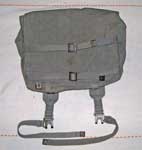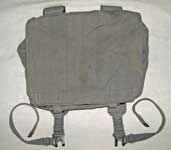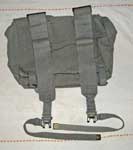Pattern 1925 Blue-grey Web Equipment - Haversacks and Packs
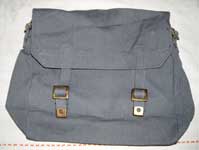
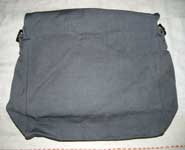
 The Pattern 1925 Haversack was introduced with the Web Equipment, R.A.F., Pattern 1925, under Air Ministry Weekly Order No. 793/1927, as Stores Ref. 23/82. It is similar to the Patt. '19 Haversack, but all fittings on the rear have been deleted - this Haversack is designed to be suspended from the Braces only, and does not have provision to be worn on the back. Like the Patt. '14 and Patt. '19 Haversacks, it is approximately 9-inches tall by 11-inches wide, and is tapered in profile, deeper (4-inches) at the bottom than at the top (2-inches). This Canadian made example is maker marked "ZL&T" (Zephyr Loom & Textile) and dated 1941. From the Karkee Web Collection.
The Pattern 1925 Haversack was introduced with the Web Equipment, R.A.F., Pattern 1925, under Air Ministry Weekly Order No. 793/1927, as Stores Ref. 23/82. It is similar to the Patt. '19 Haversack, but all fittings on the rear have been deleted - this Haversack is designed to be suspended from the Braces only, and does not have provision to be worn on the back. Like the Patt. '14 and Patt. '19 Haversacks, it is approximately 9-inches tall by 11-inches wide, and is tapered in profile, deeper (4-inches) at the bottom than at the top (2-inches). This Canadian made example is maker marked "ZL&T" (Zephyr Loom & Textile) and dated 1941. From the Karkee Web Collection.
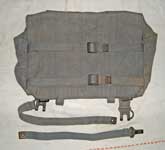
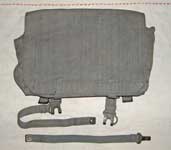
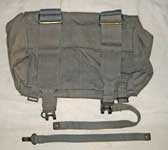 The Pattern 1925 Rucksack, top part, was introduced with the Web Equipment, R.A.F., Pattern 1925, under Air Ministry Weekly Order No. 793/1927, as Stores Ref. 23/86. There are two horizontal 3/4-inch straps on the face of the Rucksack, as shown in the picture far left. In the R.A.F., these were used to secure the steel helmet. However, the drawing at right below is taken from Mills Equipment Company Patent No. 177380, dated 30th March, 1922. It shows another use for these straps, but it should be noted that there is an additional strap (A6), which is not present on the R.A.F. version. When the straps are not being used, the rucksack's cover is closed over them. The Rucksack, top part has integral 2-inch shoulder straps that loop over the shoulder on top of the Braces and connect to the buckles at the top of the Cartridge carriers. Each shoulder strap has a 3/4-inch side strap as well.
The Pattern 1925 Rucksack, top part, was introduced with the Web Equipment, R.A.F., Pattern 1925, under Air Ministry Weekly Order No. 793/1927, as Stores Ref. 23/86. There are two horizontal 3/4-inch straps on the face of the Rucksack, as shown in the picture far left. In the R.A.F., these were used to secure the steel helmet. However, the drawing at right below is taken from Mills Equipment Company Patent No. 177380, dated 30th March, 1922. It shows another use for these straps, but it should be noted that there is an additional strap (A6), which is not present on the R.A.F. version. When the straps are not being used, the rucksack's cover is closed over them. The Rucksack, top part has integral 2-inch shoulder straps that loop over the shoulder on top of the Braces and connect to the buckles at the top of the Cartridge carriers. Each shoulder strap has a 3/4-inch side strap as well.  These connect to buckles on the the bottom of the Rucksack, top part, when it is worn alone, and to buckles on the bottom of the Rucksack, bottom part, when both halves are worn. The Airman's term for this Rucksack, with its many straps and attachments, was The Octopus. On the first version of the Rucksack, the side strap on the left is attached to the shoulder strap buckle, while one on the left is detachable. Instead of being sewn in place, it is attached to the shoulder strap buckle with a flat brass hook. This allows the Rucksack to be more easily removed. For a discussion of this Rucksack supporting strap (or Kicking strap, as it was sometimes called in service), see the Web Equipment, Pattern 1925 (Blue-Grey) Belts and Straps Section. This Canadian made example is maker marked "MS&U Ltd." (Montreal Suspender & Umbrella, Ltd.) and dated 1940. From the Karkee Web Collection.
These connect to buckles on the the bottom of the Rucksack, top part, when it is worn alone, and to buckles on the bottom of the Rucksack, bottom part, when both halves are worn. The Airman's term for this Rucksack, with its many straps and attachments, was The Octopus. On the first version of the Rucksack, the side strap on the left is attached to the shoulder strap buckle, while one on the left is detachable. Instead of being sewn in place, it is attached to the shoulder strap buckle with a flat brass hook. This allows the Rucksack to be more easily removed. For a discussion of this Rucksack supporting strap (or Kicking strap, as it was sometimes called in service), see the Web Equipment, Pattern 1925 (Blue-Grey) Belts and Straps Section. This Canadian made example is maker marked "MS&U Ltd." (Montreal Suspender & Umbrella, Ltd.) and dated 1940. From the Karkee Web Collection.
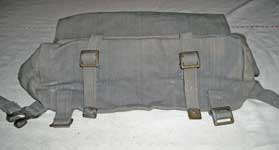 A view showing the bottom of the Rucksack, top part. In this view you can see the connections used to attach the Rucksack, bottom part.
A view showing the bottom of the Rucksack, top part. In this view you can see the connections used to attach the Rucksack, bottom part.
Another example of the Rucksack, top part. This is the second version, with the detachable Rucksack supporting strap replaced by an integrally sewn 3/4-inch side strap on the left side as well as the right. KW have seen only a few examples of this type. This example is maker marked "D.R.W. Ltd." and dated 1941. From the Karkee Web Collection.
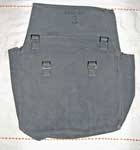
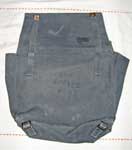 The Pattern 1925 Rucksack, bottom part, was introduced with the Web Equipment, R.A.F., Pattern 1925, under Air Ministry Weekly Order No. 793/1927, as Stores Ref. 23/87. The Rucksack, bottom part attaches to the Top part to provide additional carrying capacity. Unlike the Rucksack, top part, it cannot be worn alone. The intention is that non-essential items of kit are carried in the Bottom part. In troop movements, the Rucksack, bottom part, can be removed from the Top part, closed, and carried by mechanised transport. Although the Bottom part can be attached to the Top part when closed, it is normally attached open. This allows items to be easily removed without disconnecting the two halves. This example is maker marked "M.E. Co." and dated 1927. From the Karkee Web Collection.
The Pattern 1925 Rucksack, bottom part, was introduced with the Web Equipment, R.A.F., Pattern 1925, under Air Ministry Weekly Order No. 793/1927, as Stores Ref. 23/87. The Rucksack, bottom part attaches to the Top part to provide additional carrying capacity. Unlike the Rucksack, top part, it cannot be worn alone. The intention is that non-essential items of kit are carried in the Bottom part. In troop movements, the Rucksack, bottom part, can be removed from the Top part, closed, and carried by mechanised transport. Although the Bottom part can be attached to the Top part when closed, it is normally attached open. This allows items to be easily removed without disconnecting the two halves. This example is maker marked "M.E. Co." and dated 1927. From the Karkee Web Collection.
